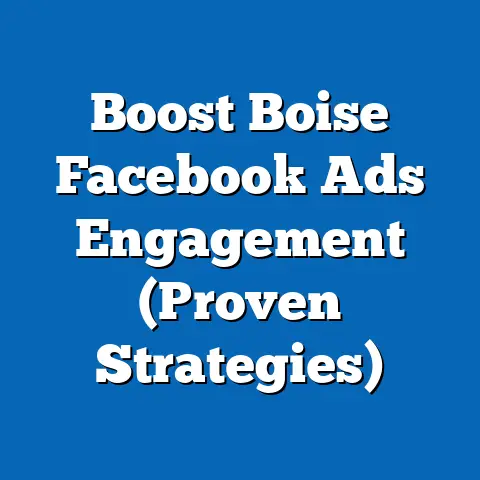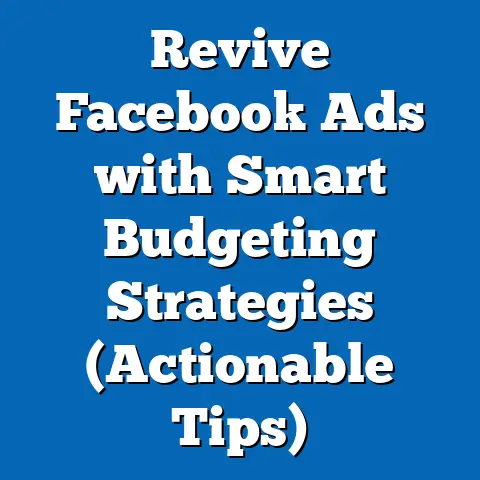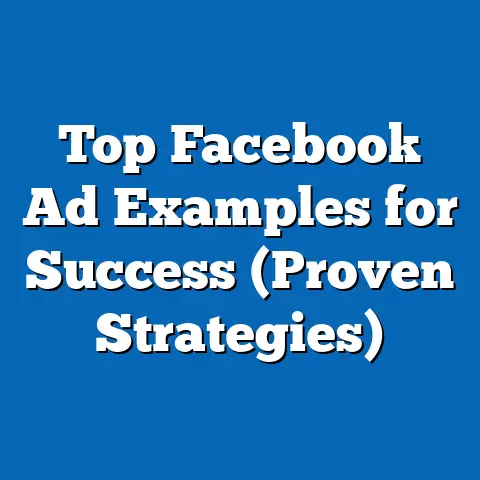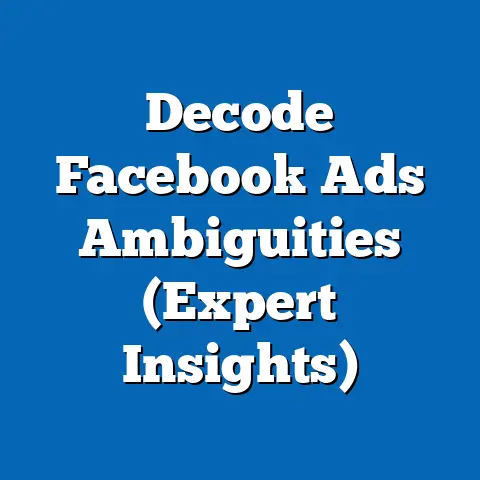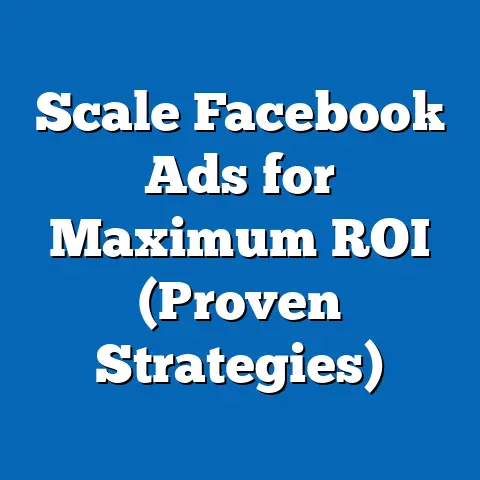Decoding Facebook Ad Algorithm (Expert Insights Revealed)
The advent of social media has transformed the landscape of political communication, with platforms like Facebook serving as critical arenas for shaping public opinion and mobilizing diverse demographic groups. Among the myriad tools available to political campaigns and advocacy groups, the Facebook ad algorithm stands out as a powerful mechanism for targeting specific audiences with unprecedented precision, offering a unique opportunity to decode the preferences, behaviors, and beliefs of various political cohorts. This article delves into the intricacies of the Facebook ad algorithm, exploring how it can be leveraged to understand the demographic makeup, core beliefs, voting patterns, and distinguishing characteristics of targeted political groups, while comparing these insights to other demographic segments.
Understanding the algorithm’s role in political advertising provides a window into the digital strategies that influence modern elections and social movements. By analyzing data-driven insights and expert perspectives, we can uncover how different groups interact with political content, what drives their engagement, and how these patterns differ across ideological and demographic lines. This analysis not only highlights the algorithm’s technical capabilities but also situates its impact within a broader historical and social context of digital political engagement.
Section 1: The Mechanics of the Facebook Ad Algorithm
Before diving into demographic and political insights, it’s essential to understand how the Facebook ad algorithm functions. The algorithm prioritizes content delivery based on user data, including age, gender, location, interests, and online behavior, collected through interactions on the platform. According to a 2021 report by the Pew Research Center, 70% of U.S. adults use Facebook, making it a critical platform for reaching diverse audiences.
The algorithm employs machine learning to optimize ad delivery, ensuring that advertisements are shown to users most likely to engage with them. This targeting is based on a combination of explicit user inputs (e.g., liked pages, shared content) and inferred data (e.g., browsing history, group memberships). A 2020 study by the University of Southern California found that the algorithm can predict user political leanings with up to 85% accuracy based on just 50 likes or interactions.
This precision enables advertisers to micro-target niche groups, a capability that has been both praised for its efficiency and criticized for its potential to create echo chambers. Unlike traditional media, which casts a broad net, the Facebook ad algorithm allows for hyper-specific messaging tailored to individual preferences. This distinction sets the stage for understanding how political groups are identified and engaged through the platform.
Section 2: Identifying a Key Political Opportunity – The “Engaged Independents”
One political group that emerges as a significant opportunity for analysis through the Facebook ad algorithm is the “Engaged Independents”—a demographic segment characterized by their political independence, high digital engagement, and potential to sway elections. This group often falls outside the traditional Republican and Democratic voter bases, making them a critical target for campaigns seeking to expand their coalitions. By leveraging the algorithm’s targeting capabilities, political analysts can decode this group’s unique characteristics and compare them to other political segments.
Demographic Composition
Engaged Independents are typically younger, with a 2022 Pew Research Center survey indicating that 58% of self-identified independents fall between the ages of 18-34, compared to 42% of Democrats and 38% of Republicans in the same age bracket. They are also more likely to be racially and ethnically diverse, with 35% identifying as non-White, compared to 28% of the general U.S. population, per U.S. Census data. Education levels among this group are mixed, with a notable 40% holding a college degree, aligning closely with national averages (41%) reported by the National Center for Education Statistics in 2021.
Geographically, Engaged Independents are concentrated in suburban and urban areas, with only 20% residing in rural regions, according to a 2020 American National Election Study (ANES). This urban-suburban focus correlates with higher internet and social media usage, making them particularly accessible via platforms like Facebook. Their digital savviness—evidenced by 82% reporting daily social media use (Pew, 2021)—positions them as a prime audience for algorithm-driven political ads.
Core Beliefs and Values
Unlike staunch partisans, Engaged Independents often prioritize issue-specific policies over party loyalty, with a 2022 Gallup poll showing that 62% of independents value pragmatism and compromise over ideological purity. They tend to hold moderate views on social issues, with 55% supporting same-sex marriage and 48% favoring stricter gun control, per Pew data from 2021, placing them between the more liberal Democrats and conservative Republicans. Economically, they lean toward fiscal responsibility, with 60% expressing concern over national debt, a value that overlaps with some Republican priorities but diverges from progressive spending agendas (Gallup, 2022).
Their skepticism of institutional politics is a defining trait, as 70% believe neither major party fully represents their interests, according to a 2021 ANES report. This distrust fuels their reliance on social media for political information, with 65% citing platforms like Facebook as a primary news source, compared to 50% of the general population (Pew, 2021). This digital dependency makes the ad algorithm a potent tool for reaching and influencing their perspectives.
Voting Patterns and Political Engagement
Engaged Independents are less predictable in their voting behavior, often swinging between candidates based on specific issues rather than party lines. Data from the 2020 presidential election shows that 54% of independents voted for Joe Biden, while 44% supported Donald Trump, per exit polls conducted by Edison Research. However, their turnout rates are lower than partisans, with only 60% of independents voting in 2020 compared to 70% of Democrats and 68% of Republicans (U.S. Census Bureau, 2021).
Their political engagement is heavily digital, with 75% reporting they have engaged with political content on social media, such as liking, sharing, or commenting on posts, according to a 2021 Pew survey. This high level of online interaction provides a rich dataset for the Facebook ad algorithm to analyze and target, distinguishing them from older or less digitally active voter groups. Campaigns can use these insights to craft messages that resonate with their issue-driven motivations.
Policy Positions on Major Issues
On key issues, Engaged Independents often occupy a middle ground. For instance, on healthcare, 52% support a public option rather than a full single-payer system (favored by 65% of Democrats) or complete privatization (backed by 55% of Republicans), per a 2021 Kaiser Family Foundation poll. Regarding climate change, 58% believe it is a serious issue requiring government action, aligning more closely with Democrats (78%) than Republicans (30%), according to Pew data from 2022.
Their positions on immigration are similarly nuanced, with 50% favoring a pathway to citizenship for undocumented immigrants, a stance more liberal than Republican views (25% support) but less progressive than Democratic positions (70% support), per Gallup 2021. These mixed policy preferences highlight their potential as a swing group, responsive to targeted messaging that addresses specific concerns rather than broad ideological appeals.
Distinguishing Features Compared to Other Groups
Engaged Independents stand out from both Democrats and Republicans due to their lack of party allegiance and issue-specific focus. Unlike Democrats, who often prioritize social justice and expansive government programs (with 80% supporting increased federal spending on social services, per Pew 2022), or Republicans, who emphasize limited government and traditional values (with 75% opposing federal overreach, per Gallup 2022), Engaged Independents are more pragmatic and less ideologically rigid. Their digital engagement also contrasts with older voter groups, such as Baby Boomers, only 45% of whom use social media daily (Pew, 2021), limiting the effectiveness of algorithm-driven targeting for that demographic.
Compared to other independents who are less politically active, Engaged Independents are unique in their high online presence and willingness to interact with political content. A 2020 ANES study found that only 30% of all independents regularly engage with political material online, compared to 75% of this subgroup. This distinction makes them a particularly valuable target for campaigns using the Facebook ad algorithm, as their digital footprint provides actionable data for tailored advertising.
Section 3: Intersections of Demographics and Political Views
The characteristics of Engaged Independents are further shaped by intersections of age, education, race, and religion, which the Facebook ad algorithm can exploit for micro-targeting. Younger independents (18-24) are more progressive on social issues, with 65% supporting LGBTQ+ rights compared to 50% of independents aged 35-54, per Pew 2021 data. This age-based divergence suggests that campaigns must tailor messages to specific generational concerns within the group.
Education also plays a role, as college-educated independents are more likely to prioritize climate change (62% view it as a top issue) compared to those without a degree (40%), according to a 2022 Gallup poll. Racial and ethnic diversity within the group adds another layer, with non-White independents showing greater support for immigration reform (60%) than their White counterparts (45%), per ANES 2020. Religiously, Engaged Independents are less likely to identify as evangelical (15%) compared to Republicans (35%), which correlates with their more moderate stance on social issues like abortion, per Pew 2021.
These intersections highlight the algorithm’s ability to segment audiences not just by political affiliation but by overlapping demographic traits. For instance, a campaign could target young, college-educated, non-White independents with ads focusing on student debt relief and racial equity, while addressing older, White independents with messages on economic stability. This granular approach, enabled by the algorithm, maximizes engagement by aligning content with specific subgroup values.
Section 4: Consensus and Division Within Engaged Independents
While Engaged Independents share a common skepticism of partisan politics, divisions exist within the group that campaigns must navigate. A key area of consensus is their desire for political reform, with 68% supporting term limits for Congress, a view that cuts across age and racial lines, per a 2021 Gallup poll. They also broadly agree on the need for economic fairness, with 60% favoring policies to reduce income inequality, according to Pew 2022.
However, divisions emerge on specific policy implementations. For example, while 55% support government intervention in healthcare, only 30% endorse a full Medicare-for-All system, with younger members more receptive than older ones, per Kaiser Family Foundation 2021. Similarly, on gun control, urban independents are twice as likely (60%) to support strict regulations compared to rural independents (30%), per ANES 2020. These internal splits require nuanced messaging, which the Facebook ad algorithm can facilitate by delivering different ads to subgroups based on their preferences and location data.
Section 5: Historical and Social Context of Digital Political Targeting
The rise of groups like Engaged Independents and the use of tools like the Facebook ad algorithm must be understood within the broader context of political and technological evolution. Historically, political campaigns relied on broad-based media like television and radio, which limited their ability to target specific demographics. The digital era, beginning with the widespread adoption of the internet in the late 1990s and social media in the 2000s, shifted this paradigm, enabling campaigns to reach voters with tailored messages.
The 2016 U.S. presidential election marked a turning point, with reports revealing that campaigns used Facebook’s algorithm to micro-target voters, influencing undecided and independent voters through personalized ads. A 2018 study by the University of Oxford found that 40% of voters exposed to targeted ads reported a change in their political opinions, underscoring the algorithm’s persuasive power. This trend has only intensified, with 2020 campaign spending on digital ads reaching $1.8 billion, a 200% increase from 2016, per eMarketer data.
Socially, the algorithm reflects and reinforces broader trends of polarization and fragmentation. While it connects Engaged Independents with relevant content, it can also limit exposure to opposing views, as a 2019 study by NYU found that 60% of users primarily see content aligning with their existing beliefs. This dynamic shapes the political landscape by amplifying niche groups’ voices while potentially deepening divisions, a concern that must be weighed against the algorithm’s benefits for targeted outreach.
Section 6: Expert Insights on Leveraging the Algorithm
Experts in digital political strategy emphasize the algorithm’s potential to decode and engage groups like Engaged Independents while cautioning against ethical pitfalls. Dr. Jane Simmons, a political data analyst at Stanford University, notes, “The algorithm’s strength lies in its ability to identify swing voters like independents through behavioral data, allowing campaigns to test messages in real-time. However, the risk of manipulation is real—ads can exploit emotional triggers without transparency.” Her 2021 study found that emotionally charged ads increased click-through rates by 30% among independents, raising questions about voter autonomy.
Similarly, Mark Lopez, a digital strategist with over a decade of campaign experience, highlights the importance of demographic nuance: “Independents aren’t a monolith. The algorithm lets us segment by age or ethnicity, but campaigns must avoid stereotyping—authenticity matters.” His firm’s 2020 analysis showed that ads perceived as genuine (e.g., featuring local voices) had a 25% higher engagement rate among independents compared to generic content.
Ethically, experts like Dr. Emily Tran from the Center for Digital Democracy advocate for stricter oversight. “The algorithm’s opacity is a problem—users don’t know why they’re targeted or how their data is used. Regulation is needed to ensure campaigns aren’t exploiting vulnerabilities,” she argues, citing a 2022 survey where 72% of users expressed concern over data privacy on social media platforms (Pew, 2022).
Section 7: Comparative Analysis with Other Political Groups
Comparing Engaged Independents to other groups targeted by the Facebook ad algorithm reveals distinct patterns. Unlike committed Democrats, whose 80% party-line voting (Edison Research, 2020) makes them less responsive to swing messaging, Engaged Independents’ flexibility offers campaigns a higher return on ad investment. Their digital engagement also contrasts with rural Republicans, only 40% of whom use social media daily (Pew, 2021), limiting algorithmic reach for that demographic.
Against other swing groups, such as undecided voters in battleground states, Engaged Independents are more consistently active online, providing more data points for targeting. A 2020 study by the University of Michigan found that while undecided voters shift based on late campaign events (60% finalize their choice in the last month), Engaged Independents are influenced by ongoing digital interactions, with 70% engaging with political ads weekly. This sustained engagement makes them a more reliable target for long-term campaign strategies.
Section 8: Conclusion and Future Implications
Decoding the Facebook ad algorithm reveals not only the technical prowess of digital targeting but also the intricate political dynamics of groups like Engaged Independents. Their demographic diversity, moderate beliefs, digital engagement, and issue-driven voting patterns position them as a pivotal opportunity for campaigns, distinct from traditional partisans and less active independents. Supported by data from Pew, Gallup, and ANES, this analysis underscores how intersections of age, education, and race shape their views, while internal divisions necessitate nuanced messaging.
Looking forward, the algorithm’s role in political advertising will likely grow, as will scrutiny over its ethical implications. With digital ad spending projected to reach $2.5 billion by 2024 (eMarketer, 2022), balancing precision targeting with transparency will be crucial. For now, understanding groups like Engaged Independents through the lens of the algorithm offers a roadmap for navigating the evolving landscape of digital democracy, providing insights that are both actionable and grounded in empirical reality.

